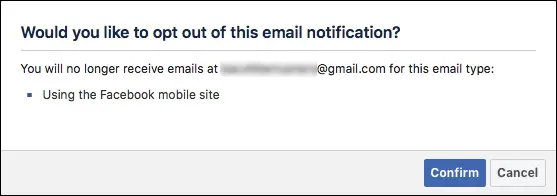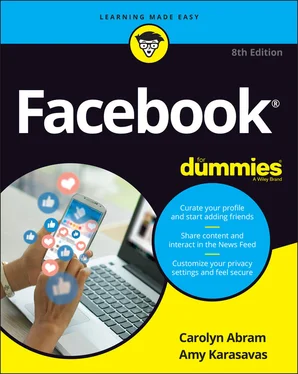1 ...6 7 8 10 11 12 ...23 Officially, all you need to join Facebook is a valid email address or valid mobile number. When we say valid email, we mean that you need to easily access the messages in that account because Facebook emails you a registration confirmation. A valid mobile number means a mobile phone number that can send and receive text messages, because Facebook will text you your registration confirmation. Figure 2-1 shows the crucial part of the sign-up page, which you can find by navigating to www.facebook.com .
As you can see, you need to fill out a few things:
First and Last Name: Facebook is a place based on real identity. Sign up with the name people know you by. We don’t recommend signing up with a fake name or alias because that will make it hard for your friends to find you on the site. After you’ve signed up, you can add nicknames or maiden names to your timeline to make it even easier for friends to find you. But for now, just use your real first and last name.
Mobile Number or Email: You need to enter your valid email address or mobile phone number here. If you enter your email, you'll need to do so twice to make sure there are no typos.
New Password: As with all passwords, using a combination of letters, numbers, and punctuation marks is a good idea for your Facebook password. It’s probably not a good idea to use the same password for every site you join, so we recommend using something unique for Facebook. Facebook requires passwords to be at least six characters.
Birthday: Enter your date of birth. If you’re shy about sharing your birthday, don’t worry: You’ll be able to hide this information on your timeline later.
Gender (Female, Male, or Custom): Facebook uses your gender information to construct sentences about you on the site. For example, you might see a News Feed story that reads “Amy updated her profile picture.” Your gender options are Female, Male, or Custom. You must choose one. If you choose Custom, you'll see a drop-down menu to select your preferred pronoun. Your options are she/her, he/him, or they/them. Your pronoun will be visible to everyone on Facebook, and Facebook will use it to construct sentences about you. In the text field below the pronoun menu, you can enter your gender separately if it differs from your pronoun or you want to add more context to your gender identity. You can also leave this gender text field blank.
After you fill out this information, click Sign Up (the big green button). Congratulations: You've officially joined Facebook!

FIGURE 2-1:Enter information here to create a Facebook account.
 When you click Sign Up, you’re agreeing to Facebook’s terms of service, data policy, and cookies policy. Most websites have similar terms and policies, but if you’re curious about just what Facebook’s are, you can click the blue Terms, Data Policy, and Cookies Policy links just above the big green Sign Up button.
When you click Sign Up, you’re agreeing to Facebook’s terms of service, data policy, and cookies policy. Most websites have similar terms and policies, but if you’re curious about just what Facebook’s are, you can click the blue Terms, Data Policy, and Cookies Policy links just above the big green Sign Up button.
After you sign up for Facebook, you'll immediately receive an email in your inbox asking you to confirm your account. This may be the first of many emails Facebook sends you as it helps you get fully integrated into the Facebook world. Read on to learn how to respond to these emails and why they are important.
Confirmation is Facebook’s way of trying to make sure you are really you and that the email address you used to sign up is really yours. When you click the Sign Up button, Facebook sends you an email asking you to confirm your account. In other words, Facebook is double-checking that you are the person who owns your email address.
 If Facebook is asking you to confirm your email but you aren’t seeing that email in your inbox, try checking your spam or trash folder. Sometimes Facebook emails can wind up there by accident.
If Facebook is asking you to confirm your email but you aren’t seeing that email in your inbox, try checking your spam or trash folder. Sometimes Facebook emails can wind up there by accident.
Go to your email, look for the Facebook message, and open it. (It will usually have a subject such as Welcome to Facebook or Facebook Confirmation .) That email contains a link or button. Your confirmation email may also contain a confirmation code that you will be asked to enter on Facebook’s website. Click the link or button, enter the confirmation code if prompted, and you will be confirmed.
After you’ve confirmed your email address Facebook considers you a full-fledged member of the site. However, it doesn’t want you to show up once and leave, so it may email you to remind you that you're now a Facebook user. These outreach emails have various subject lines, ranging from a notice that one of your new Facebook friends has updated his or her status, to a general notice that “You have more friends on Facebook than you think.” Clicking the links in these emails will open Facebook in your browser.
If you don’t like receiving these emails, you can unsubscribe by clicking the Unsubscribe link at the bottom of any individual email. Facebook opens in your browser and asks if you're sure you want to unsubscribe from this type of email, as shown in Figure 2-2. Click Confirm to make it official.

FIGURE 2-2:Keep your inbox free of clutter.
 When Facebook asks whether you want to unsubscribe from “this type” of email, it is being specific. Email updates about your friends (such as, Amy added new photos on Facebook ) are a different type than general prompts to find more friends. You may have to click Unsubscribe from more than one email before you stop receiving emails altogether.
When Facebook asks whether you want to unsubscribe from “this type” of email, it is being specific. Email updates about your friends (such as, Amy added new photos on Facebook ) are a different type than general prompts to find more friends. You may have to click Unsubscribe from more than one email before you stop receiving emails altogether.
Now that your account is confirmed, you’re ready to take Facebook by storm. Although you have this book to help guide you through the ins and outs of Facebook, lots of Facebook users do not. (How sad for them!) That’s why Facebook provides its users with numbered steps to help start them on the right foot.
In some cases, depending on whether you were invited to join Facebook by a friend or you joined with an email address from your workplace or school, you may see slightly different numbered steps than those detailed in the following sections. Don’t worry if this is the case; the same principles apply. This section covers the most basic parts of getting started: finding friends and making yourself recognizable to them by adding a profile picture.
Step 1: Adding a profile picture
Your Facebook timeline is the online representation of who you are. Most likely, you have online profiles for various websites. Facebook timelines tend to be a little more comprehensive and dynamic, for reasons that we detail in Chapter 5.
Your profile picture is one of the most important parts of your timeline. It’s a good first step to telling your friends all about you. And, significantly, it helps your friends identify you once you start sending friend requests.
You can add a profile picture by uploading a photo from your computer’s hard drive.
Читать дальше


 When you click Sign Up, you’re agreeing to Facebook’s terms of service, data policy, and cookies policy. Most websites have similar terms and policies, but if you’re curious about just what Facebook’s are, you can click the blue Terms, Data Policy, and Cookies Policy links just above the big green Sign Up button.
When you click Sign Up, you’re agreeing to Facebook’s terms of service, data policy, and cookies policy. Most websites have similar terms and policies, but if you’re curious about just what Facebook’s are, you can click the blue Terms, Data Policy, and Cookies Policy links just above the big green Sign Up button. If Facebook is asking you to confirm your email but you aren’t seeing that email in your inbox, try checking your spam or trash folder. Sometimes Facebook emails can wind up there by accident.
If Facebook is asking you to confirm your email but you aren’t seeing that email in your inbox, try checking your spam or trash folder. Sometimes Facebook emails can wind up there by accident.
 When Facebook asks whether you want to unsubscribe from “this type” of email, it is being specific. Email updates about your friends (such as, Amy added new photos on Facebook ) are a different type than general prompts to find more friends. You may have to click Unsubscribe from more than one email before you stop receiving emails altogether.
When Facebook asks whether you want to unsubscribe from “this type” of email, it is being specific. Email updates about your friends (such as, Amy added new photos on Facebook ) are a different type than general prompts to find more friends. You may have to click Unsubscribe from more than one email before you stop receiving emails altogether.










